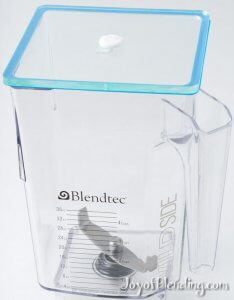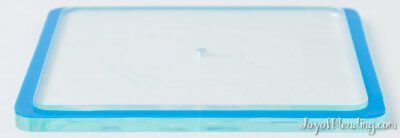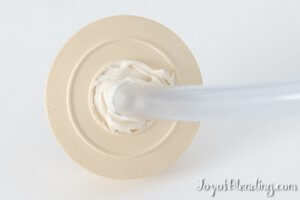 Do you want to convert your Blendtec blender into a vacuum blender? If so, this post is for you! My first Blendtec vacuum lid didn’t work, but this second-generation design works perfectly.
Do you want to convert your Blendtec blender into a vacuum blender? If so, this post is for you! My first Blendtec vacuum lid didn’t work, but this second-generation design works perfectly.
Note: this sort of DIY approach likely voids the Blendtec warranty. That said, I haven’t encountered any problems resulting from vacuum blending. I confirmed that the Blendtec bearing seal holds up to the vacuum, as no air bubbles come in the bottom in a vacuumed container of water.
The tops of Blendtec jars are flat, so my first idea was to simply seal it with a gasket and a flat piece of acrylic. However, under vacuum, the walls of the jar bow in. As they bow in, the middle of the wall tops move down slightly, while the corners stay in place. This makes the top of the jar no longer flat, and it starts leaking.
My solution is to cut a second piece of acrylic that just fits inside the top of the Blendtec jar. I then attach that piece to a larger piece of acrylic. The inner piece keeps the walls of the jar from bowing in, and the top piece seals over a flat gasket.
Cutting Acrylic
It’s easy to get the shape right because the top of Blendtec jars are square with rounded corners. I used a laser cutter, but if you can’t find a laser cutter to use, you could cut a square and then cut off the corners with straight diagonal cuts. (The rounded corners are not critical to this design, though they do make it look nicer.)
I cut the inner piece from ⅛” acrylic sheet and the top piece from ¼” acrylic sheet. These pieces are small enough that you can likely source them from scrap pieces for cheap, or possibly free. I’ve found scraps at TAP plastics as well as at the community “fab lab” laser cutter facility. (You could cut both pieces from ¼” acrylic, but that would be overkill. It would probably be OK to cut both from ⅛”, but I think that might be borderline not strong enough.)
For the Blendtec Wildside container, the vector file I sent to the laser cutter for the inner piece is a 5.13″ x 5.13″ square with 0.3″ radius rounded corners, and a 0.18″ hole in the center. The top piece is ¼” larger than the inner piece on all sides. (That makes it a 5.63″ x 5.63″ square with 0.33″ rounded corners, and the same 0.18″ hole in the middle.)
One-way Valve
I use a simple silicone one-way valve on the hole in the lid. I make a flat dime-sized disc by squeezing silicone caulk onto wax paper, and I also make a skinny cylinder with a right-angle bend. Once the two pieces cure, I glue them together with a tiny dab of fresh silicone caulk. The bent cylinder is smaller than the hole in the acrylic, and it lets air escape while holding the disc in place.
I’ve also seen people use a piece of partially attached electrical tape over a small hole as a one-way valve.
Gasket
I made a gasket by cutting out a piece of silicone sheet. I’ve tested a few of the available silicone sheets, and this one is the thickest I’ve seen, which I think will make it hold up the best. The thinner sheets also work, and the one in the photos is this one. You can use the larger piece of acrylic to trace out the outer edge of the gasket, and then use the inner piece to trace out the inner edge of the gasket. (I was tempted to laser cut the silicone sheet, but I heard that it smokes too much, so I cut it with an X-Acto blade.) In principle you might be able to make a gasket from silicone caulk, but I have not had success with that.
Sandwiching Acrylic
Then I used acrylic cement to sandwich together the two pieces of acrylic. This was my first time sandwiching flat pieces of acrylic together, and I should have used more cement. The lid works fine, but it would look better if I had used enough cement to fully flood the area between the pieces. (I thought it would spread more than it did: each drop spread to about the area of a dime.) Once the cement cures, the lid is ready to use.
 I do not glue the gasket in place. It fits snugly around the inner piece, so it stays in place, but if I ever need to change it, I can just pull it off.
I do not glue the gasket in place. It fits snugly around the inner piece, so it stays in place, but if I ever need to change it, I can just pull it off.
To apply vacuum over the one-way valve, I use an adapter made from a rubber drain plug. I drilled a hole in it, inserted a piece of tubing, and glued it with silicone caulk. It looks like this:
I’m using the same pair of vacuum pumps that I use with my Vitamix vacuum container, but you could use whatever vacuum pump you like.
Happy vacuum blending!


Hi,
thank you so much for this blob about the vacuum lid for Blendtec blenders.
Do you know if there is any “ready-to-buy” solution for that lid?
Also i just wanted to add, that there is a hard plastic lid available to buy, directly from Blendtec, why did you haven’t use that for the DIY vacuum lid experiment? Wouldn’t that be easier to build?
Please let me know what you think?
Thank you so much, and keep blending! 🙂
Kind Regards from Germany
Roland
I do not know of a ready-to-buy vacuum lid for Blendtec.
I didn’t use the stock Blendtec lid because it doesn’t hold a vacuum. I’m also not sure what you mean by a hard plastic Blendtec lid. The Blendtec lids I’m familiar with are rubbery with a hard central lid plug.
Ah, I think this is the lid Adam was referring to:
https://www.blendtec.com/products/hard-lid
HARD LID
Built to produce an airtight seal, perfect for smoothies, frozen drinks, slushes and more. Dishwasher safe. Fits both WildSide+ and FourSide jars. To be used on jars within sound enclosures.
I had not seen that lid before. (I focus on the consumer lines, and that’s a commercial part.) I see that it is available on Amazon. If it truly forms an airtight seal, it should be possible to use it if you drilled a small hole in it to attach the vacuum. I suspect that it wouldn’t actually form an airtight seal though, because it looks like it’s a single piece of hard plastic, with no gasket material. Maybe you could add a DIY gasket, similar to the one I made in this post to get it to seal.
Now that I’m looking at the commercial lids, I see they also make a solid soft lid. My guess is that one has a higher chance of sealing to vacuum with no added gasket, but there is the question of if it would be rigid enough to not deform too much under vacuum.
Hi, great article thank you! Would love to see you test the pitcher full of water under vacuum and watch for any bubbles from the bearing. My concern is that you might be pulling bearing grease into your smoothies
That was a concern of mine as well, and I did that exact test. Sorry I don’t have video.
How long does it take to “vacuum” the blendtec jar using your two pump setup? My FoodSaver style vacuum sealer takes 60 seconds to “vacuum” an 8 oz. Mason jar.
I have a Wildside+ jar and had to slightly alter the dimensins of the inner piece to the following: 1/8″ x 5 1/16″ x 5 1/16″ with 1/4″ rounded corner.
It works great, although I’m still on the lookout for a thicker piece of silicone for the gasket and a better option than electrical tape for the valve.
Thank You for sharing this great project!